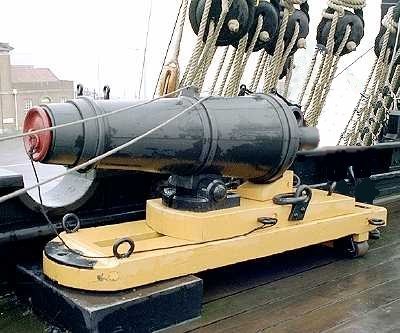
The HMS Victory’s [Admiral Nelson’s] two 68 pounders are mounted on the fo’c’sle and could unleash a storm of grapeshot across an enemies deck prior to boarding. At the battle of Trafalgar Victory devastated one of the Bucentaures’ gun decks when it fired a 68 pound round shot and a keg of musket balls through the stern gallery.
Heartened by this support, on 28 December 1781 the Navy Board recommended two 68-pounder carronades be allowed to all classes of ship capable of supporting them, and 42- and 32-pounders to those of smaller rates – on the request of their captains. Moreover, `as we wish the merits of these guns to be tried on a larger scale, and to increase if possible by their means the number of ships capable of acting in a line of battle’, the Navy Board proposed the Rainbow of 44 guns be fitted completely with carronades. Both the Admiralty and the Ordnance Board complied. A list of ships supplied with carronades of 22 July 1782 records the Rainbow equipped as requested, the only naval warship at that time fitted completely with these guns. Her armament was tested at the Nore on 31 July 1782 with eight naval captains present, before she was sent for trial at sea. There her success was dramatic. On 11 September 1782 the Rainbow’s master, Charles Duncan, reported from Plymouth that she had `taken and brought in here the Hebe French frigate of 40 guns 300 men, without any action more than firing the starboard carronade on the forecastle . . . 26 times’.
By July 1782, 36 ships of the line had been fitted with 166 carronades, 77 frigates with 530 carronades, and 45 smaller vessels with 278 carronades. In all, the Ordnance department had issued at least 978 carronades to 158 vessels. To supply the guns, in April 1782 the Carron Company was casting and finishing between 60 and 80 carronades a week, devoting nearly its entire production to the gun. Carronades continued to be supplied, but hostilities with the European powers arising from the American war were terminated by order on 13 February 1783.
By that time the reputation of the carronade was established, and the Ordnance Board won over. Technical refinements followed. The critical reduction of windage gave rise to the proposal for an experienced gunner on each gun wharf to inspect shot and ensure they were rust free and rubbed with grease. To accustom new-raised men to using the guns, the Admiralty had carronades placed on receiving ships and the gunners of ships in Ordinary attend to exercise them daily. It submitted instructions for the guidance of these gunners and proposed that gun locks, suggested in January 1781 by Captain Sir Charles Douglas, be used for carronades as well as long guns. Other modifications included a nozzle of a few inches to project their blast more clear of a ship’s upper works; a mounting ring under the gun to obviate the need for trunnions; a vertical screw thread through the rear button to facilitate elevation and depression; and sights along the barrel. In consequence the carronade became slightly longer and heavier, but more manageable and accurate.
The carronade received greater use in the wars from 1793. A new establishment of carronades for ships, superseding that of 1779, was adopted on 19 November 1794. Significantly, Sir Charles Middleton was an Admiralty commissioner from May 1794, becoming the senior naval lord in March 1795. From August 1795 every ship bigger than a 16-gun brig was ordered to be supplied with a carronade for her launch. From March 1798 every line of battle ship was fitted to receive carronades on the quarter-deck and forecastle. In 1799 the carronade was made the general quarter-deck and forecastle gun of frigates. From 21 February 1800, 20- and 24-gun frigates were fitted for 32-pounder carronades on their main decks rather than long 9-pounders. Almost inevitably they spread too to French and Spanish vessels, which carried 36-, 32- and 24-pounder carronades.
Some prejudice among sea officers remained. Lord St Vincent observed to Captain George Murray in April 1799: `the rage for carronades in ships of the line passes my understanding; they are a great strain upon the decks and sides, extremely dangerous in action, and create so much noise and confusion, where silence and attendance on the braces should preside, that I never suffer one to be mounted in a ship I serve on board of’. Yet others were devotees. From 1793 Nelson kept two 68-pounder carronades with him, transferring them as he moved from ship to ship. Their ability to clear decks of men and damage rigging tailor-made them for Nelson’s preferred close-range battle. Hence he asserted `no captain can do very wrong if he places his ship alongside that of an enemy’.